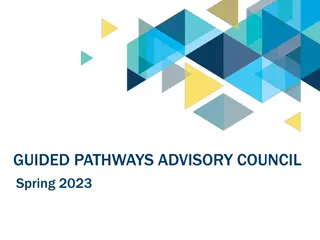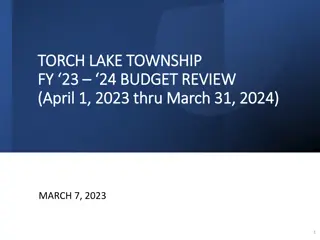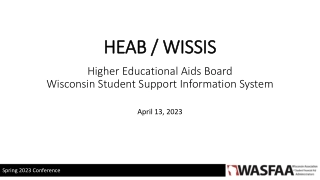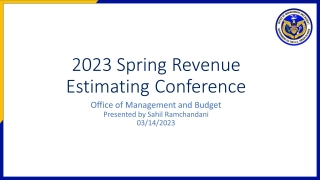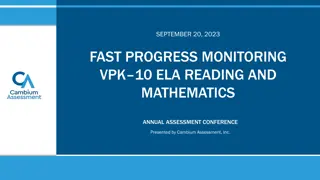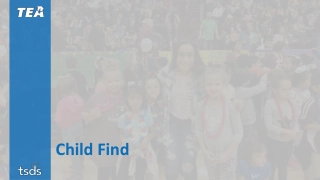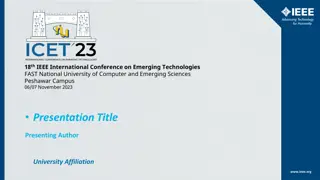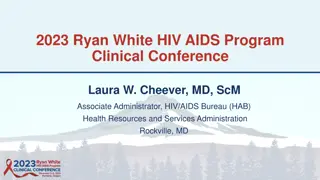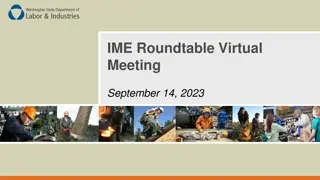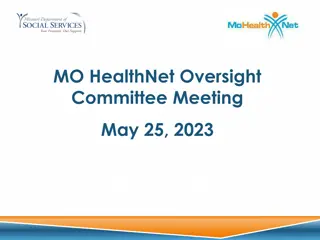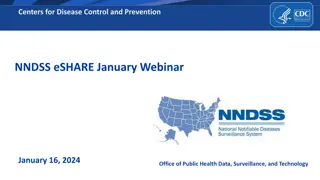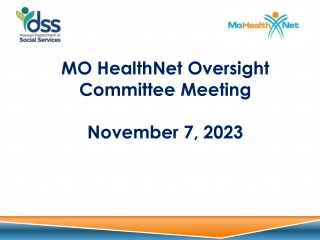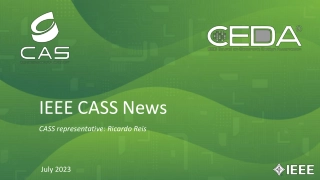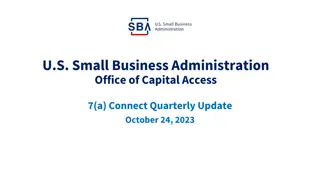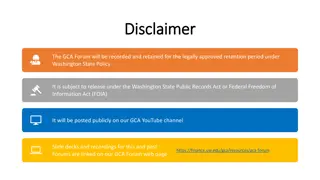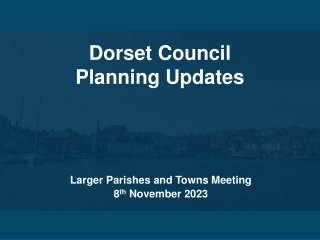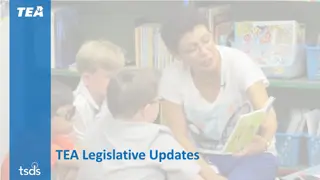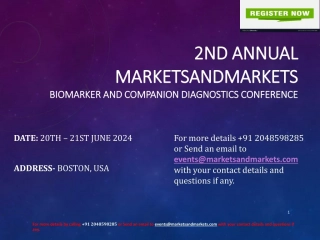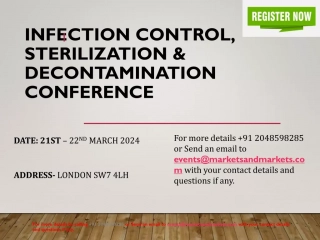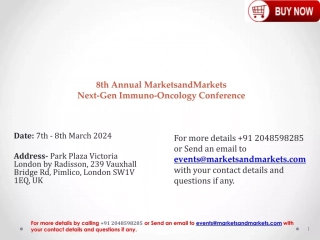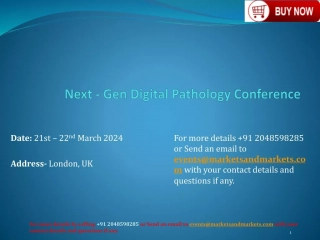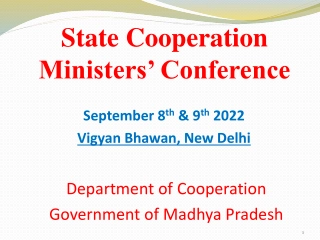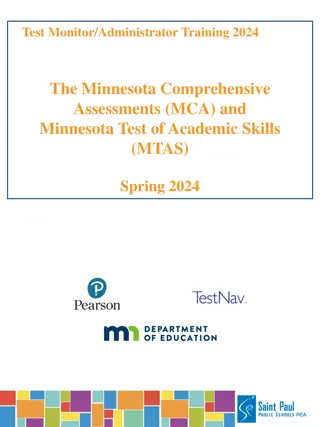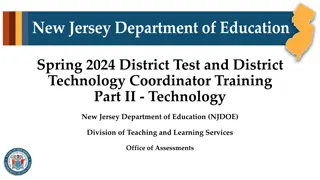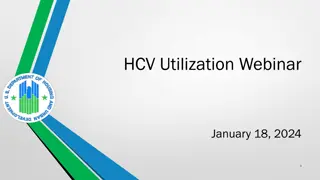TORCH Conference Spring 2023 Updates and Topics
The TORCH Conference Spring 2023, featuring J. Brandon Durbin, CPA, covers various topics including reimbursement law changes, low volume payments, Medicare DSH and 340B programs, CAH mileage modifications, and more. The conference provides important updates for healthcare providers and facilities. Find out about recent legislations and eligibility criteria affecting healthcare reimbursement.
TORCH Conference Spring 2023 Updates and Topics
PowerPoint presentation about 'TORCH Conference Spring 2023 Updates and Topics'. This presentation describes the topic on The TORCH Conference Spring 2023, featuring J. Brandon Durbin, CPA, covers various topics including reimbursement law changes, low volume payments, Medicare DSH and 340B programs, CAH mileage modifications, and more. The conference provides important updates for healthcare providers and facilities. Find out about recent legislations and eligibility criteria affecting healthcare reimbursement.. Download this presentation absolutely free.
Presentation Transcript
TORCH Conference Spring 2023 J. Brandon Durbin, CPA 101 W Renner Rd, Ste 475, Richardson Tx 75082 brandon@dhcg.com 469-361-0120 (o) 214-538-8491 (c)
Topics Updates and Current Events Reimbursement Law Changes Low Volume Payments Medicare DSH / 340B CAH Mileage Transparency REH Waiver Update DSH, UC, CHIRP, RAPPS, HARP, TIPPS, QIPP. Local Funds Monitoring & IGT Funding Issues COVID What s the Future Scan to get your copy NOW
Low Volume Payment Adjustment Congress did pass a two-year extension to the Low Volume Payment adjustment in December 2022 (Section 4101 and 4102 Consolidations Appropriations Act of 2023) This Act extends the LVPA for the period Oct 2022 Sept 2024 Hospitals less than 3800 total discharges Hospitals that are more than 15 miles from nearest IPPS hospital We appreciate TORCH s attention and work toward the inclusion of the LVPA into the Appropriations Bill.
Medicare DSH and 340B Can Eligibility PPS hospitals (incl rural classifications), CAH, rural referral centers (RRC), Children s hosp, Freestanding Cancer facilities Prospectively Paid Hospitals Not classified as Sole Community (SCH) Medicare Disproportionate Share (DSH) Payment percentage 11.75% or greater from most recent CR Sole Community (SCH) Medicare DSH Payment percentage 8% or greater from most recently filed CR Trend in Pharmaceutical companies toward reducing participation for those hospitals that have multiple contracts. Companies are encouraging only one retail outlet or indicating a primary outlet.
Medicare DSH and 340B Can 340B Program requirements HRSA rules mandate hospital s notification of ineligibility in 340B program upon filing of CR indicating lack of eligibility. HRSA mandates hospital cease purchasing drugs at 340B pricing on day hospital files the CR FAQ on HRSA website addressing amended / reopened cost reports and lack of retroactive application for 340B eligibility.
Modified COP for CAH Mileage Hospitals - November 2022 Revision in OP final rule adds a key statement to the Definition of a Primary Road Pertains to the 35-mile proximity test for CAH certification Former statute Primary Road is any numbered Federal highway or a four-lane (two lanes each direction) roadway. Approved revision to the rule Primary Road would include any numbered Federal highway or other roadway with four lanes (two or more lanes in each direction). Similar to description for numbered state highways and excludes numbered federal highways with only one lane in each direction (or less than 4 lanes).
CAH Mileage Revision adds a key statement to the Definition of a Primary Road Pertains to the 35-mile proximity test for CAH certification This revision impacts approx. 10 hospitals in the state of Texas Recommendations: Evaluate reimbursement impact and operational strategies in conversion to CAH Conversion considerations Average length of patient stay Available and licensed beds Enrollment process
Price Transparency This is continuing to gain momentum CMS / HHSC compliance and audits are starting. Have had one completed. Press & Politics We believe the compliance efforts by state & federal will continue to increase. Data can be useful in negotiation of managed care contracting Data can be harmful in politics National Academy for State Health Policy (NASHP). https://nashp.org Backed by insurance companies, and is showing distorted profitability data of hospitals. Hospitals could cover all uninsured cost at Medicare rates by private insurance https://tool.nashp.org
Rural Emergency Hospital (REH) New provider type created by Consolidated Appropriations Act (CAA) 2021 Final Rules included in 2023 OPPS Proposed Rule issued in November 2022. Must be Medicare enrolled CAH or rural hospital with 50 beds or less on date CAA was signed to convert to REH (December 27, 2020) Submit change of information CMS-855A rather than initial enrollment application
REH contd. REH must provide Emergency Department and Observation Care services; may include other outpatient services elected by the REH No acute care inpatient services Can provide post-hospital extended care services furnished in distinct part unit licensed as skilled nursing facility Must have transfer agreement with Level I or Level II trauma center Annual per patient average of 24 hours or less in the REH Maintain quality measures and reporting as established by CMS
REH contd. Payments for REH services begin January 1, 2023 Claims payments for billed OP services PLUS; Monthly facility payment Ideally, facility payment is designed to cover excess ER cost over claims processing. Estimated Monthly REH facility payment CY (Calendar Year) 2023 - $3.2M annually (estimated) Or approx $270,000 per month per OPPS 2023 Medicare rule Payment for REH services equal to established OPPS rate for the same service plus 5% Includes off-campus provider-based OP departments Ambulance services will be paid under Ambulance fee schedule SNF paid per RUG rates no cost-based swing bed under REH
REH contd. Hospital OPPS payment Example Charges $1,300 total - $975 ER charge combined with a $325 radiology scan Under CAH payment methodology ER cost / charge ratio - Radiology cost / charge ratio - .974498 1.303713 Under REH payment methodology Total OPPS APC charges $1,300. Gross Reimb - ER visit Radiology scan Total $950. $423. Bundled Gross OPPS Payment $ 556. $1,373. Less Deduct Net Reimb $ 1,099. Total Variance between CAH and OPPS $ 274. Less Deduct / Coins Net Reimb $ 203. $ 353. ($ 746)
REH contd. A Few Things to Consider: For all hospitals: Volume of IP Services now and over next 10 years Community Perspective of eliminating Inpatient Volume / Care / potentially staffing Impact to Medicare Advantage and other Payors (incl Medicaid and Commercial) Can provide telehealth services under REH For CAHs: Volume of swing bed services and difference in Cost Based vs RUG rate payment model Difference between Outpatient Cost Based Pmts. vs OP PPS Payment model Adding back in Hospital Facility Payment trended over time.
Is REH the solution? Maybe . For a very small subset of the hospitals, it s a temporary solution. Shrinking communities Those that would close otherwise. Communities will not like this, if there is another way to have care, but it is better than no care. Other options CHART Well CMS killed that program for no participation (3/17/23) This program needs to get better before it will really mean more than a temporary lifeline.
DSH & UC rules New proposed rules are in draft, and will be published Friday. The draft has significant changes. No hospital specific, but by class there is 35% increase in Rural Public for DSH. $33M in all funds. A slight decrease in the UC of -1%. Due to the DSH offset.
Reporting Issues How to keep from getting a dirty letter Medicaid Managed Care percentage should be 80-95% of your total Medicaid. They look at this ratio for accuracy in reporting. 94% of the Medicaid is Managed Care. Round 2, the denominator should be 2x of the Round 1 denominator. If not, you need an explanation. They are looking for increasing compliance. This does not occur if you counted your patients in Round 1.
Uncompensated Care (UC) Key Dates DY12 Final IGT DY13 Advance IGT DY13 Final IGT - September 6, 2023 (Settlement Date) - Projected February 2024 - Projected September 2024
UC Issues Data is still the key to all these waiver programs. We have seen hospitals harmed by poor data availability. For presumptive charity, you MUST actually write these accounts off. Several clients have the report, but have not integrated this into their revenue cycle
CHIRP Y2 R2 Reporting- Due April 30th Component 1 Reporting 1. Health Information Exchange (HIE) Participation- NOT reported this round. 2. Learning Collaborative Participation- NOT reported this round. 3. Medication Reconciliation: # of Unintentional Med Discrepancies per Patient (All Payer) If implemented but have fewer than the 76 minimum interviews, submit all you have completed. Since most facilities do not have a process, you report zero. Most rural facilities report Zero. Component 2 Reporting- 2 Measures for Rural Also for RAPPS 1. Tobacco Use: Screening & Cessation Intervention Percentage of patients aged 18 years and older who were screened for tobacco use one or more times within 12 months AND who received tobacco cessation intervention if identified as a tobacco user 2. Influenza Immunization- 2 time periods to consider (Patient is counted (MET) if in EITHER time period) Percentage of patients aged 6 months and older seen for a visit between January 1- March 31, 2022 who received an influenza immunization OR who reported previous receipt of an influenza immunization August 1, 2021- March 31, 2022. Percentage of patients aged 6 months and older seen for a visit between October 1- December 31, 2022 who received an influenza immunization OR who reported previous receipt of an influenza immunization August 1, 2022- December 31, 2022. Reporting measurement period for Round 2: 1/1/22 to 12/31/22 (Influenza Immunization differs) Payer stratification for Component 2: Medicaid Managed Care, Other Medicaid, Uninsured, and All Payer This is a struggle. They are looking for about 94% in Medicaid Managed Care vs Traditional Medicaid.
CHIRP Reporting- Proposed Year 3 Component 1 Reporting 1. Health Information Exchange (HIE) Participation Reporting only 2. Learning Collaborative Participation 2. Non-Medical Drivers of Health Screening (New Structure Measure; Added to All DPPs) Status of screening for food insecurity, housing, & transportation needs. 3. Medication Reconciliation: # of Unintentional Med Discrepancies per Patient Will year 4 require performance? Component 2 Reporting- 2 Measures for Rural 1. Tobacco Use: Screening & Cessation Intervention Counseling/pharmacotherapy can now occur 6 mo. prior to measurement period. No exclusions for medical reason for not screening; only exclusion is Hospice. 2. Influenza Immunization (still on RAPPS) 2. Screening for Depression & Follow-up Plan (New Process Measure) Patients aged 12 years and older screened on date of encounter (or up to 14 days prior) using an age-appropriate standardized tool, AND who received a documented follow-up plan within 2 days after the encounter if positive for depression.
CHIRP Key Dates April 30, 2023 - PY2, Round 2 Reporting Due to HHSC Measurement Period January 1, 2022- December 31, 2022 Office Hours for Questions TEAMS Meeting April 12th, 19th, and 26th 11-11:30 a.m. - Estimated IGT Settlement Date (PY3 1stIGT) June 2, 2023 June 21- July 22, 2023- PY2 Corrections Period Round 2 reporting Summer 2023 - PY3 Webinar by HHSC Measures & Specification Changes October 31, 2023 - PY3, Round 1 Reporting Due to HHSC Measurement Period January 1, 2023- June 30, 2023 November 17, 2023 - Estimated IGT Settlement Date (PY3 2nd IGT)
RAPPS Y2 R2 Reporting- Due April 30th Component 1 Reporting- NOT reported this round 1. Care coordination 2. Telemedicine/telehealth capabilities 3. Electronic health record (E.H.R.) use Component 2 Reporting 1. A1C Poor Control (>9.0%) Percentage of patients aged 18-75 with diabetes whose most recent hemoglobin A1C during the measurement period (January 1, 2022- December 31, 2022) was >9.0% OR do not have an A1C result recorded. 2. Influenza Immunization- 2 time periods to consider (Patient is MET if MET in EITHER time period) Percentage of patients aged 6 months and older seen for a visit between January 1- March 31, 2022 who received an influenza immunization OR who reported previous receipt of an influenza immunization August 1, 2021- March 31, 2022. Percentage of patients aged 6 months and older seen for a visit between October 1- December 31, 2022 who received an influenza immunization OR who reported previous receipt of an influenza immunization August 1, 2022- December 31, 2022. Payer stratification: Medicaid Managed Care, Other Medicaid, Uninsured, and All Payer
RAPPS Reporting- Proposed Year 3 Component 1 Reporting 1. Care coordination 2. Telemedicine/telehealth capabilities 3. Electronic health record (E.H.R.) use 1. Non-Medical Drivers of Health Screening (New Structure Measure; Added to All DPPs) Status of screening for food insecurity, housing, & transportation needs 2. Health Information Exchange (HIE) Participation (New Structure Measure; Also in CHIRP) 3. Depression Screening & Follow-up Practices (New Structure Measure) Component 2 Reporting 1. Controlling High Blood Pressure Percentage of patients aged 18-85 with hypertension whose most recent blood pressure during the measurement period was <140 (systolic) and <90 (diastolic). 2. Influenza Immunization- 3 Big Changes Timeline change: Percentage of patients aged 6 months and older seen for a visit between October 1, 2022- March 31, 2023 who received an influenza immunization OR who reported previous receipt of an influenza immunization July 1, 2022- June 30, 2023. Patient attestations to receiving the immunization no longer count as MET. Patient refusals, allergies, and vaccine not available are no longer exclusions. Payer stratification: Medicaid Managed Care, Other Medicaid, Uninsured, and All Payer
RAPPS Key Dates April 30, 2023 - PY2, Round 2 Reporting Due to HHSC Measurement period January 1, 2022- December 31, 2022 Office Hours for Reporting Questions April 12th, 19th, and 26th 10:30- 11a.m. - Estimated IGT Settlement Date (PY3 1st IGT) - PY2 Corrections Period - PY3 Webinar by HHSC Measures & Specification Changes - PY3, Round 1 Reporting Due to HHSC Measurement period January 1, 2023- June 30, 2023 - Estimated IGT Settlement Date (PY3 2nd IGT) June 7, 2023 June 21- July 22, 2023 Summer 2023 October 2023 November 30, 2023
HARP Notice the rural decline Very few Traditional Medicaid Patient in rural The pain isn't worth the gain ?
Hospital Augmented Reimbursement Program (HARP) # of Participating Hospitals Year 2 (FFY23) # of Participating Hospitals Year 1 (FFY22) Year 2 Total Payments Year 1 Total Payments SDA Bexar 2 $ 39,045,212 4 $ 54,062,659 Dallas 2 $ 190,683,820 2 $ 200,666,811 El Paso 1 $ 16,848,054 1 $ 30,090,566 Harris 3 $ 413,004,546 4 $ 356,670,390 Jefferson 0 $ - 2 $ 25,331 Lubbock 2 $ 2,786,732 6 $ 6,173,865 MRSA Central 0 $ - 3 $ 51,800 MRSA Northeast 1 $ 25,320 2 $ 139,461 MRSA West 11 $ 1,987,669 34 $ 5,566,901 Nueces 1 $ 370,972 4 $ 638,298 Tarrant 2 $ 68,469,984 2 $ 58,019,739 Total 25 $ 733,222,308 64 $ 712,105,821
HARP Key Dates May 4, 2023 May 31, 2023 January 5, 2024 - Estimated Settlement Date (PY3 1st IGT) January 31, 2024 - Estimated Payment (PY3 1st Payment) - Estimated IGT Settlement Date (PY2 2nd IGT) - Estimated Payment (PY2 2nd Payment)
TIPPS Very little rural participation Mainly an urban program & a governmental teaching program. Slides have data if you want it.
TIPPS Y2 R2 Reporting- Due April 30th TIPPS Reporting- Proposed Year 3 Component 1 Reporting Proposed Change from 8 Reported Measures to 3 1. Influenza Immunization 2. Tobacco Use: Screening & Cessation Intervention 3. Tobacco Use and Help with Quitting Among Adolescents (Previously in Comp 2) Component 2 Reporting Proposed Change from 10 Reported Measures to 4 1. Childhood Immunization Status (Updated) 2. Immunization for Adolescents 3. Hemoglobin A1c Testing 4. Controlling High Blood Pressure (Updated) Component 3 Reporting Proposed Change from 6 Reported Measures to 5 1. Depression Response at Twelve Months (Updated) 2. Health Information Exchange (HIE) Participation 3. Screening for Depression & Follow-up Plan (Updated)
TIPPS Key Dates April 30, 2023 - PY2, Round 2 Reporting Due to HHSC Measurement period January 1, 2022- December 31, 2022 Office Hours for Reporting Questions April 13th, 20th, and 27th 10-10:30 a.m. - Estimated IGT Settlement Date (PY3 1st IGT) - PY2 Corrections Period - PY3 Webinar by HHSC Measures & Specification Changes - PY3, Round 1 Reporting Due to HHSC Measurement period January 1, 2023- June 30, 2023 - Estimated IGT Settlement Date (PY3 2nd IGT) June 5, 2023 June 21- July 22, 2023 Summer 2023 October 31, 2023 November 21, 2023
DPP Contact Information Sign-up for Notifications https://service.govdelivery.com/accounts/TXHHSC/subscriber/new Measure Specification & Performance Requirement Questions DPPQuality@hhs.texas.gov Financial, Eligibility, and IGT Questions CHIRP, RAPPS, HARP PFD_Hospitals@hhsc.state.tx.us TIPPS DPP BHS PFD_TIPPS@hhs.texas.gov PFD_DPPBHS@hhs.texas.gov LoFTS Questions PFD_LFM@hhs.texas.gov
Do we miss our Anchor calls? We think, based on the feedback from our clients that we need to have these types of calls periodically. CHIRP and other applications Reporting questions A rural friendly call, not dominated by the major health systems. Two ideas A cloud depository of all the HHSC materials, even those that are outdated Hosting a Anchor type call, by region or other Me may not know the answer, but at least we will try and find it. And its free If you are interested in these types of calls, please email Sherri Powell sherrip@dhcg.com
QIPP Update Year 5 Concerns Component 1 Allocation / Reconciliation This is out last week. Several payables and receivables, by each MCO. May affect future payments The IGT refund is a couple months past due from HHSC. Performance Improvement Plan (PIP) has removed some providers. This will continue to grow in the future to tie into pay for performance guidelines.
Local Funds Monitoring (LoFTS) Four phases/modules of initial reporting (only GEs report; no private providers): Module 1- LPPFs Module 2- Hospital programs outside of LPPF DSH, UC, CHIRP, DSRIP, NAIP, HARP Module 3- Non-hospital programs outside of LPPF Due April 30, 2023 at 11:59 p.m. RAPPS, QIPP, TIPPS, DPP-BHS, ICF-UPL, UC Dental/UC Physician, NAIP, DSRIP If all DSRIP IGT was reported in Module 2, you do NOT have to report DSRIP again here. Corrections posted 4/5/23 to the LoFTS page regarding reporting eligibility. Module 4- Ambulance & school-based services Yearly reporting each October moving forward In-depth reviews 114 of 163 Module 2 providers were selected, based on a risk assessment score. (Black Box). Budget(s), board minutes approving budget(s) for the FFY22 Details on Other Income Bank statements showing ad valorem taxes going in and IGT going out for FFY22
LoFTS The items requested are based on the latest CMS OIG review of Parkland. Parkland OIG asks for $400M in return. Based on Tax Revenue Parkland did not isolate other dollars Parkland could not identify how patient revenue was eligible or how the dollars were identified. Dollars do not have names attached to them . Backdoor MFAR regulations Texas has sued CMS in the EDTX.
The State of IGT The monitoring is going to have consequences Parkland case is an example They do not want to allow patient revenue They are asking for unavailable/unattainable isolation of IGT funds Risk areas Small public / private relationships with rent QIPP rely on patient revenue. IGT s in excess of tax revenue. LPPF s Recent CMS memo prohibits private to private arrangements Lawsuit in EDTX A win may not matter long term. LPPF advantage over public IGT, is that the Tax is a cost and they get partially reimbursed for their cost of IGT.
MJ-LPPF Multi Jurisdictional LPPF s are already in law H&S Code 300A. Slight tweaks in the legislation of 300B (State-wide regular LPPF) and 300A was proposed to allow more flexibility, but due to the EDTX case this is now out of the bill. LPPF s generally require multi hospitals in their jurisdiction MJ LPPF allows multiple jurisdiction with only 1 hospital Can have public hospitals, unlike the other LPPF which is private only.
MJ-LPPF Multi counties, cities or districts where only one hospital is in the defined area, join and form a board to jointly assess a tax rate The LPPF Hold Harmless EDTx case will apply Through a CO-OP, other programs could help alleviate the issues. Max tax is 6% of net revenue of the hospital cost report, however that is defined. Only a hospital can participate. Districts with out a hospital or non- hospital based entities cannot.
Rural Healthcare Relief Grant What you need to know Tier 2 (Competitive Award) was issued in November $100k - $999k per hospital You have 9 months to spend these funds and a survey from HHSC will be issued in August for you to describe how these funds were utilized by the below categories (be sure you are not overlapping with PRF/ARP funds): Infrastructure Personnel PPE Lost Revenue
Waiver Programs TNIP Texas Network Improvement Program Non budget neutral program. 5% of total Medicaid MCO spend. A pilot is working on this for MRSA West Will have a set aside for rural Is based on MCO Medicaid revenue. Funding follows the patient. Rural hospitals will need to engage in metric reporting to qualify. A Rural TNIP could be developed, with a better focus for rural CHIRP/TNIP Rural needs to engage for more funding share and funding of access.
Threats! Medicaid Advantage is growing decreasing rural payments Managed care contracting in general. No scale! Medicaid waiver payments have been reduced UPL 4Private UPL 4DSRIP 4QIPP 4UC 4CHIRP 4? COVID was a boom . But the funds & volume are almost gone, but the cost are still here. Staffing cost is seeming to level, but other cost increases are permanent So ., What s the next thing What if there is not a thing
Innovation (CMS style) P4P Pays for paper .. Lots of reporting? Does it move the needle? ACO s Who actually makes the money? They want your volume and participation, but who gets paid? CHART Cancelled BPCI Very low participation. JAMA study states it cost money There are NO rural hospitals inside the Washington Beltway
We need a new message We get lots of fixes and new ideas, but what we need is a long-term sustainable competitive fairness / rates. The problem is that rural encompasses such a broad range of sizes. Its not a one size fits all solution. Rural needs some protection form Advantage. Not just higher payments, but something to encourage the insurance company. If we get higher rates, then we are the high cost provider and they will steer care away. The CAH copayment needs a solution, as CAH is disadvantaged. Managed care in general ignores rural. Take it or leave it contracts, and some just don t care.
When a loss is a gain There is always two sides to the coin. Example - The new HHA payment system is causing closure of many small agencies. The public (SEC) companies believe that s good for business as they are more efficient and can have more patients. You can t beat efficiency. Size matters in contracting and in all negotiations.


